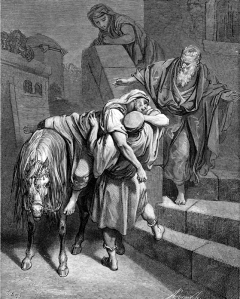Category Archives: Uncategorized
#WordPress Ads
My posts are now being littered with WordPress Ads over which I have no control.
(Maybe it is their way of discouraging free wordpress blogs, hoping one will subscribe to be rid of them. It certainly does not generate any income for them on my blog with few readers)
Please do not encourage them by clicking on any of the ads.
On I Thessalonians: Not Leaving Context Behind
While sitting with my bed-ridden mother during the afternoon, I outlined First Thessalonians after reading her a Psalm.
Paul ends this letter, “I charge you before the Lord to have this epistle read to all the brethren.”
In days gone by, when we received a letter in the mail from family or friends, we read the whole thing. When we pick up our Bibles and turn to any epistle, we should first read the whole thing before we begin a piecemeal reading of it.
Context makes clear the mistakes of that special sect of fellow American evangelicals who find their “Left Behind” drama and movies here in Thessalonians.
3:6 “But Timothy has just now come to us and has brought us good news…He has told us…”
Paul had waited eagerly for news about his Thessalonian converts. That is why they sent Timothy to them, 3:1,2.
This news prompts Paul to “pray to see you again and supply what is lacking in your faith” (3:10).
His prayer ends:
“…so that He may strengthen your hearts that you may be blameless and holy in his presence when our Lord Jesus comes with all his holy ones.”
This is the New Testament hope, the Parousia, the Second Coming of Christ.
Then, Paul begins, “Finally…” (4:1) with exhortations on how to live. The last of these exhortations begins in chapter 4 at verse 13, encouraging them
NOT “to grieve like the rest of men who have no hope.”
THAT is the key concern of this section which begins at 4:13 and ends at 5:10, which points to Christ “who died for us, so that whether we live or die, we will live together with him.”
“Therefore encourage one another…”
The news which Timothy brought (3:6) must have included the concerns of some of those Christians at Thessalonica regarding fellow believers who had already died. Would they be at some disadvantage at the Coming of the Lord?
Addressing this concern is Paul’s focus in that section, where he writes about the Second Coming, the Parousia, (NOT the ‘Left Behind’ modern teaching).
The exposition of this section is here (link) 1 Thessalonians 4
.Be an honest student/disciple and read it in context. [Social Media stats show that almost no one follows through to read that text in context. That is the state of discipleship, today.]
“…no prophecy of Scripture is a matter of one’s own interpretation” (2 Peter 1:20). Link
Be diligent to present yourself to God as one approved, a worker who doesn’t need to be ashamed, correctly teaching the word of truth. –2 Timothy 2:15
Augustine, On Genesis

In the beginning, God…
Augustine, Genesis, I.19.39
Usually, even a non-Christian knows something about the earth, the heavens, and the other elements of this world, about the motion and orbit of the stars and even their size and relative positions, about the predictable eclipses of the sun and moon, the cycles of the years and the seasons, . . . and this knowledge he holds to as being certain from reason and experience.
Now, it is a disgraceful and dangerous thing for an infidel to hear a Christian, presumably giving the meaning of Holy Scripture, talking nonsense on these topics; and we should take all means to prevent such an embarrassing situation, in which people show up vast ignorance in a Christian and laugh it to scorn. The shame is not so much that an ignorant individual is derided, but that people outside the household of faith think our sacred writers held such opinions, and, to the great loss of those for whose salvation we toil, the writers of our Scripture are criticized and rejected as unlearned men.
If they find a Christian mistaken in a field which they themselves know well and hear him maintaining his foolish opinions about our books, how are they going to believe those books in matters concerning the resurrection of the dead, the hope of eternal life, and the kingdom of heaven, when they think their pages are full of falsehoods on facts which they themselves have learned from experience and the light of reason?
Reckless and incompetent expounders of Holy Scripture bring untold trouble and sorrow on their wiser brethren when they are caught in one of their mischievous false opinions and are taken to task by those who are not bound by the authority of our sacred books. For then, to defend their utterly foolish and obviously untrue statements, they will try to call upon Holy Scripture for proof and even recite from memory many passages which they think support their position, although “they understand neither what they say nor the things about which they make assertions” [1 Timothy 1:7]. (All emphases, mine)
John Calvin, in the 16th Century, made many wise comments on Genesis:
“He who would learn astronomy…let him go elsewhere….”
”Moses wrote in a popular style things which without instruction, all ordinary persons, endued with common sense, are able to understand; but astronomers investigate with great labor whatever the sagacity of the human mind can comprehend. Nevertheless, this study is not to be reprobated, nor this science to be condemned, because some frantic persons are wont boldly to reject whatever is unknown to them. For astronomy is not only pleasant, but also very useful to be known: it cannot be denied that this art unfolds the admirable wisdom of God.”

See, also, In The Beginning
Shock and Awe in Parables of Jesus
What We Don’t Know of Jesus’ Times Deflates the Impact

The Pharisee and Publican Praying in the Temple
https://textsincontext.wordpress.com/2013/11/03/the-publican-only-half-a-surprise/
The Publican, a Jewish tax collector, was a traitor, being hated as one who worked for the occupation force of a pagan power, Rome. In rabbinic literature “hatred was to be extended even to the family of the tax collector” (ISBE).
Just pointing to a tax collector praying in the Temple would have been a shock!
The Scandal of the Samaritan
https://textsincontext.wordpress.com/2013/08/08/the-scandal-of-the-samaritan-2/
Jews despised Samaritans and viewed them as unclean foreigners. This went back in history to Assyria’s conquest of the Northern Kingdom….
Preface to The Good Samaritan : Of Lawyers, Language, and Learning (Link)
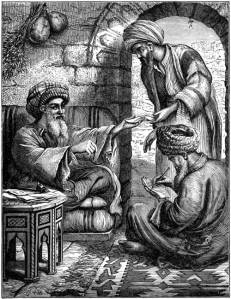 The Parable of the Dishonest Manager
The Parable of the Dishonest Manager
https://textsincontext.wordpress.com/2013/10/29/parables-surprise-and-the-american-mind/
“What?! The master praised this servant???”
A Yoke? (link)
A Mustard Seed
https://textsincontext.wordpress.com/2012/04/17/a-mustard-seed/
“…smaller than all seeds…”
For the technical mind, “all” must mean “all.” But for a parable, it is a literary device to convey the point
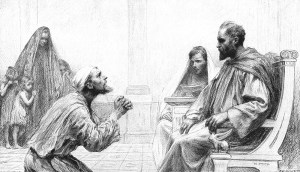 The Parable of the Unforgiving Servant
The Parable of the Unforgiving Servant
https://textsincontext.wordpress.com/2017/09/18/jesus-parable-unforgiving-sin-forgive/
Ten Thousand Talents–Have you ever heard a tall tale, or an outlandish story to which you exclaimed, “WHAT???”
The Parable of the Unforgiving Servant, Part Two
https://textsincontext.wordpress.com/2018/02/10/its-a-parable-part-two/
Chick-fil-A And the Lord’s Day: Rare Light in the Darkness

“Remember the Sabbath day, to keep it holy. 9 Six days you shall labor and do all your work, 10 but the seventh day is the Sabbath of the Lord your God. In it you shall do no work: you, nor your son, nor your daughter, nor your male servant, nor your female servant, nor your cattle, nor your stranger who is within your gates. Exodus 20
Remembering in a Forgetful World
Chick-fil-A keeps its doors closed on Sundays so that its employees have a day of rest and are able, if they wish, to go to church. Years ago, a lonely voice in Christianity Today, noted the complaint of a friend of hers who had to work on Sunday: ‘I have to work to serve all these Christians who are busy buying after church.’
The ubiquitous Sabbath-breaking of our own day is nothing new. During the revival that swept England, John Wesley noted a rare exception: “I suppose three such towns are scarce to be found again…There is no cursing, no Sabbath-breaking…”
He exhorted Christians, “Spend this day as thou hopest to spend that day which shall never end.”
On the Ten Commandments, Martin Luther told parents, “Exhort your household to learn them word for word, that they should obey God…For if you teach and urge your families things will go forward.”
The president of a denomination began his sermon at our local church with an offer of a ten dollar bill to any child who could cite the Ten Commandments in any order or form. As he put it back in his billfold he lamented that he had never been able to give it away in any church where he had preached.
Most Christians not only cannot cite the Ten Commandments in any order or form, we seem to be left with only eight or less these days. [Original essay on Teaching Children Ten Commandments–‘Your Child’s Endangered Heart’]
In A Word to a Sabbath-Breaker, Wesley wrote, “Never more disappoint the design of his love, either by worldly business or idle diversions….You have lived many years in folly and sin; now, live one day unto the Lord.”

[Please learn to share these posts. They do little good hidden in the corner.]
Remarkable Maundy Thursday!
A new commandment I give to you, that you love one another; as I have loved you, that you also love one another. By this all will know that you are My disciples, if you have love for one another. –John 13:34, 35.
“Maundy” refers to the Latin text of verse 34, mandatum, from which we get the word mandate—an authoritative command. Mandatum novum do vobis
In the Liturgy, it refers to the foot washing ceremony, the example which Jesus set for us before the new command.
The Gospel of John, which does not mention the institution of the Lord’s Supper, repeats this new mandatum three times! Peter refers to it three times in his First Epistle; First John references it five times, it being one of the tests he gives to discern true Christians. Paul refers directly to ‘love one another’ in four of his letters.
An amazing feature of our American culture stares us in the face—many Christians do not even know that in the New Testament, (link)“one another” refers exclusively to our fellow believers.
In John, Holy Week begins with the anointing of Jesus’ feet by Mary along with her wiping them with her hair. And Jesus’ last physical act, before the events of the arrest and trial, consists of his washing his disciples’ feet.
Then follows the new commandment.
“The new thing appears to be the mutual affection that Christians have for one another on account of Christ’s great love for them.”–Leon Morris, NICNT
“The standard of love which the disciples are to have for one another is that which their Lord has lavished on them.”–F. F. Bruce, John
In the early church, Tertullian remarked that pagans noted, “See how they love one another.”
Tennyson penned these lines:
Love your enemies, bless your haters, said the
greatest of the great;
Christian love among the churches, look’d the
twin of heathen hate.
Peter wrote:
Since you have purified your souls in obeying the truth through the Spirit in sincere love of the brethren, love one another fervently with a pure heart,…
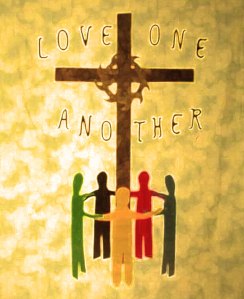
For More on Christian Confusion, see: Love, Prayer, and Forgiveness: When Basics Become Heresies (linked)
“…an excellent piece…one that many Christians need to hear”–R.C. Sproul
[Anniversary–This blog began during Holy Week, seven years ago]
Where are the disciples?

“Go therefore and make disciples of all the nations, baptizing them in the name of the Father and of the Son and of the Holy Spirit, teaching them to observe all things that I have commanded you…”–Matt. 28
We must first be a disciple before we can make a disciple.
Disciple: a learner; a follower and student of a teacher; …actively imitating both the life and teaching of the master.
Back to the Word vs. ‘What this Verse Means to Me’ (link) Read and Learn
Obedience is the key to all doors… –C.S. Lewis
Easter/Pascha Articles

Index to Easter/Pascha Posts
https://textsincontext.wordpress.com/category/easter/
(also listed in right column on this page)
It’s a PARABLE ! Part Two
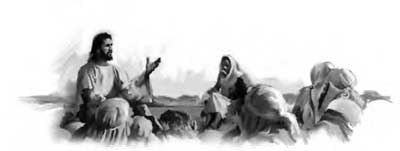
The Parable of the Unforgiving Servant
22 Jesus said to him, “I do not say to you, up to seven times, but up to seventy times seven. 23 Therefore the kingdom of heaven is like a certain king who wanted to settle accounts with his servants. 24 And when he had begun to settle accounts, one was brought to him who owed him ten thousand talents. 25 But as he was not able to pay, his master commanded that he be sold, with his wife and children and all that he had, and that payment be made. 26 The servant therefore fell down before him, saying, ‘Master, have patience with me, and I will pay you all.’ 27 Then the master of that servant was moved with compassion, released him, and forgave him the debt. . . . –Matthew 18
Part One (link) sought to show how our American minds can be derailed by details: “How do we account for this huge debt?” But the “shock and awe” of 10,000 Talents in Jesus’ day serves to grab the attention of Jesus’ listeners.
If we stay on track with this parable, we come to the clear lesson at the end: “We are in no position to repay our debt to God or to ever be able to work off that debt. We can only beg for mercy. And in the face of our outlandish debt which has been forgiven, it is equally outlandish that we servants should spurn God’s mercy by demanding the full payment of a pittance owed to us by any fellow servants as we close our ears to their pleas for forgiveness.”*
In our day when self-centered therapeutic forgiveness bumps Christ-centered Biblical forgiveness off of the tracks, we need to clearly look at the context.
Leading up to this parable, Jesus teaches about sin and forgiveness. Verse 15, “If your brother sins against you,go and tell him his fault, between you and him alone. If he listens to you, you have gained your brother…”
This prompts Peter’s question in verse 21, ‘Then Peter came to Him and said, “Lord, how often shall my brother sin against me, and I forgive him? Up to seven times?”’
Which leads into this parable of the unforgiving servant.
A parallel teaching in Luke 17 brings clarity to what we, in our day, often miss about Jesus’ instruction:
Verse 3f, “So watch what you do!If your brother sins, rebuke him, and if he repents, forgive him. 4 If he sins against you seven times in one day, and each time he comes to you saying, ‘I repent,’ you must forgive him.”
It is this plea for mercy, the repentance, that is often left out of this picture by confused Christians in our depraved world. As Jesus clearly teaches, repentance precedes forgiveness, both ours before God, and our brother’s before us.
And whether seven times or seventy times, the forgiveness is unlimited, BUT not unconditional. Jesus: “…if he repents.” (If he does not, we are commanded to take additional steps to regain our brother.)
Also, take note that Jesus is teaching about relationships between ‘brothers,’ between fellow Christians. When it comes to enemies, Jesus never says anything about forgiveness. He says to love them. And that love may lead to their repentance.
This topic of forgiveness has become more confused among many Christians than today’s confusion about love.

We need Christian disciples (i.e. learners) who will go back to the Bible and be taught the basics, and then disciple others. For a fuller discussion of this topic which focuses on the Text and draws on the best of key evangelical resources, see “Forgiveness and Repentance,” Chapter Three of: 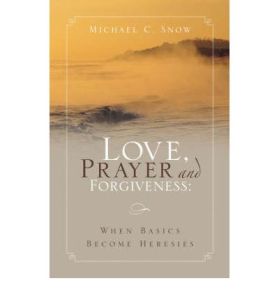
(link to reviews, details, kindle, nook, etc., ebook $3) “…an excellent piece…one that many Christians need to hear”–R.C. Sproul
Here is a Sermon on the text by R. C. Sproul. He sets the example for preaching in context. (It was a letter from R. C. Sproul that encouraged me to expand on the theme of love becoming heresy which prompted the writing of this book.)

